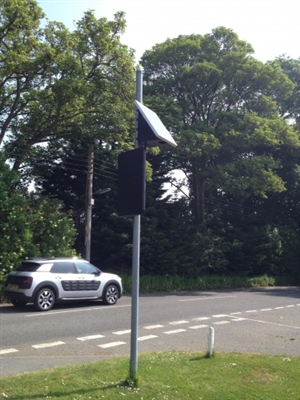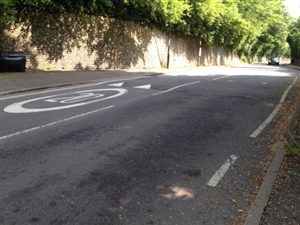
As with many small villages, there is a desire by residents to prevent through traffic and to slow down whatever vehicles do drive through. The first photo is the ‘high-tech’ part of the traffic calming scheme used. So as to abide by the planning rules that these devices should not be fixed, this solar powered device is periodically rotated through 180 degrees so that it addresses the two traffic directions. The other, similar device is relocated between various lampposts, with its battery recharged in between. In spite of waiting a while, I couldn’t get a photo of the screen illuminated. No one was speeding, so perhaps it’s doing its job.
However, these high-tech solutions are only part of the traffic calming devices employed. There are, of course, the obligatory humps in the road and an elongated number in an ellipse (so that it looks like a circle to oncoming drivers). There is only one road through the old part of the village, so there are two humps at each end. They certainly slow me down when I’m driving my 1948 MG.

 In addition to a narrowing of the road at the eastern end of the village, the other traffic calming device is a blurring of the pedestrian/vehicle space. As you can see in the photo, the pavement and road surfaces are made from the same paving blocks, with some bollards to form a ‘safe’ zone. As you approach the space you see flower beds ahead and need to drive around them. Certainly when you first drive through this space you are not sure that you should be driving there at all and you approach it very cautiously. Even after you become familiar with the space you drive slowly, particularly if there is a vehicle coming in the opposite direction.
In addition to a narrowing of the road at the eastern end of the village, the other traffic calming device is a blurring of the pedestrian/vehicle space. As you can see in the photo, the pavement and road surfaces are made from the same paving blocks, with some bollards to form a ‘safe’ zone. As you approach the space you see flower beds ahead and need to drive around them. Certainly when you first drive through this space you are not sure that you should be driving there at all and you approach it very cautiously. Even after you become familiar with the space you drive slowly, particularly if there is a vehicle coming in the opposite direction.It’s interesting to note that the nearby small town, which is also bypassed and has a thriving High Street, uses another type of traffic calming device. In spite of having several car parks (in which you now need to pay), vehicles are allowed to park on both sides of the street. There is just enough room for two cars to pass, but with two zebra crossings and people trying to parallel park, the traffic crawls through the town. Apparently, parking in the High Street is allowed so as to produce just this effect.
Returning to our own village, a combination of high-tech and very low-tech devices are used in an attempt to reduce both numbers and speed of vehicles and does a reasonable job. The learning from this is that technology helps us solve real-world problems, but often simple and low-tech solutions have a big part to play.